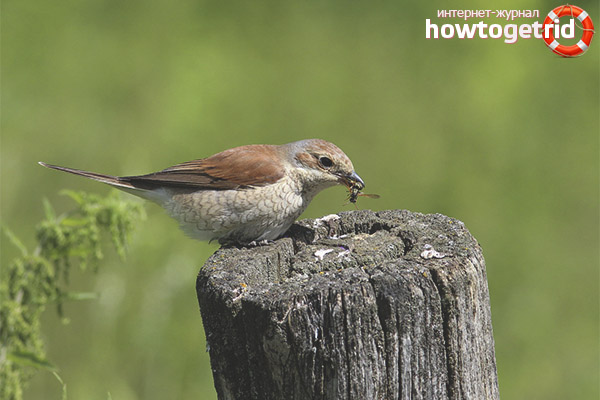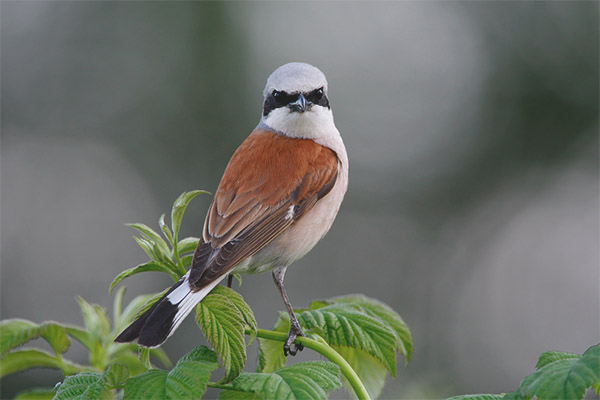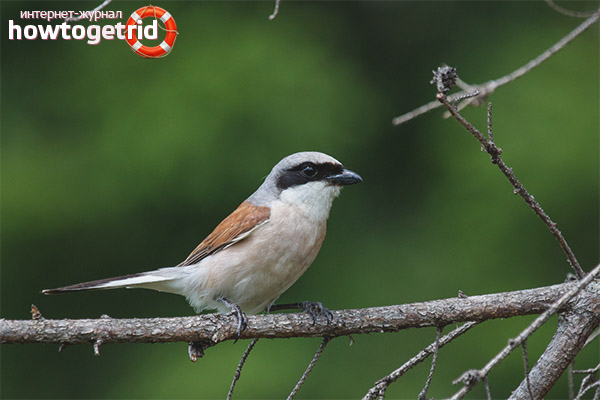The content of the article
The common red-backed bird is a bird that belongs to the family of Shriketians; it is considered to be a group of passerines. This individual has another name that sounds like a Shrike. She received this name due to the shape of her silhouette, which bears a close resemblance to a weed silhouette.
Description of the species
By its size, the common redneck exceeds the sparrow, the size of the bird’s body can be 20 centimeters, and the maximum weight of an adult individual reaches 32 grams. The upper part of the male's head, as well as his neck, is colored gray, and the chestnut tint is characteristic of the back.
Males have a long tail, like wings, it consists of black plumage. Through its entire head from the base of the beak all the way to the ear, a large strip of black color passes through the eye. On the tail of the male on both sides are contrasting stripes, painted in white.On its abdomen there is a yellow plumage, the same color as the bird's chest and the front of the neck. The nadhvoste of this bird has acquired ash-gray tones, and its sides and lower part of the chest have a pale pink tint.
The color shades of the females differ from the body color of the males, their upper part is painted in an ocher-brown hue, and the abdominal part is in off-white, on which a transverse pattern with a scaly structure is clearly distinguished. A strip of dark brown shade passes along the female's eye.
Birds of this species are distinguished from the Japanese shrike by the absence of white spots on the wings. And by the color of the plumage, located in the tail and in the upper part of the head, this bird can be distinguished from the Siberian species.
Main habitats
For its habitat, an ordinary redneck chooses light forests covered with dense shrubs.It can be found on the glades, burnt areas and forest edges. It can also inhabit river floodplains, city parks, orchards and forest belts surrounding the fields.
The period of breeding offspring
The common redneck is a mockingbird, its ability to imitate other birds is especially vivid in the mating season, when the male, attracting the female, tries to sing in different voices. For their nests, these birds choose a cover from dense bushes, for this they look for a low tree in the thickets or a fallen trunk, thickly overgrown with vegetation. In rare cases, they can make nests on the ground.
The birds of this species arrange their nests in the form of massive, coarse structures with rather thick walls. As a building material, they use twigs of various lengths, stalks of dry grass or small roots. Laying for laying, basically, are feathers, rarely can be used down or wool.
The laying of the female consists of 6 eggs, which are covered with a shell, painted in a pink or olive-yellow shade, with shapeless patches of brown color.The incubation period for Zhulans lasts up to 16 days, the female incubates the clutch, and the male provides it with food. When the chicks are born, both parents feed them. These birds manage to produce one brood per season.
To the world babies appear in a down garment, painted in dark colors, and only the head is painted in ash-gray color. Having fledged, the chicks begin to leave the nest, but they are not yet capable of soaking themselves, and somewhere within 3 weeks they need parental care.
Birds of this species with extraordinary bravery guard their offspring, even people can be attacked by four zhulans. With the threat of attack, the rogues use a kind of tactics, the female makes a distraction, dropping down and making a lot of noise, and the male attacks from the air. And at first he makes a few warning visits, but if the enemy does not let up, he will face reprisals using his beak.
Diet

In the choice of food, the common Zhulan prefers large insects, which may be locusts, various grasshoppers or beetles.Although, if possible, this bird will not give up small vertebrates, such as field mice, toads or small lizards. This small predator also poses a threat to small birds from the order of passerines - sparrows, tits, or finches. With a successful hunt, these birds are able to harvest food for the future, drying their prey on sharp branches or thorn plants.
The main characteristics of the behavior
It does not rarely happen that the rodents settle in the neighborhood of hawks, who are not afraid, arranging nests under the protection of thorny bushes. When warning young birds about danger, the adult bird twitches its tail and makes loud, rhythmic signals. They do not miss the opportunity to settle near open water bodies, where numerous frogs can become easy prey.
In the case of an enemy near the nest, the male always behaves very selflessly. Even if you managed to drive away the enemy, the male will continue his pursuit with noisy accompaniment. When there are several pairs in the settlement next door, the males can offer collective resistance.
Video: Common Shrike (Lanius collurio)












To send